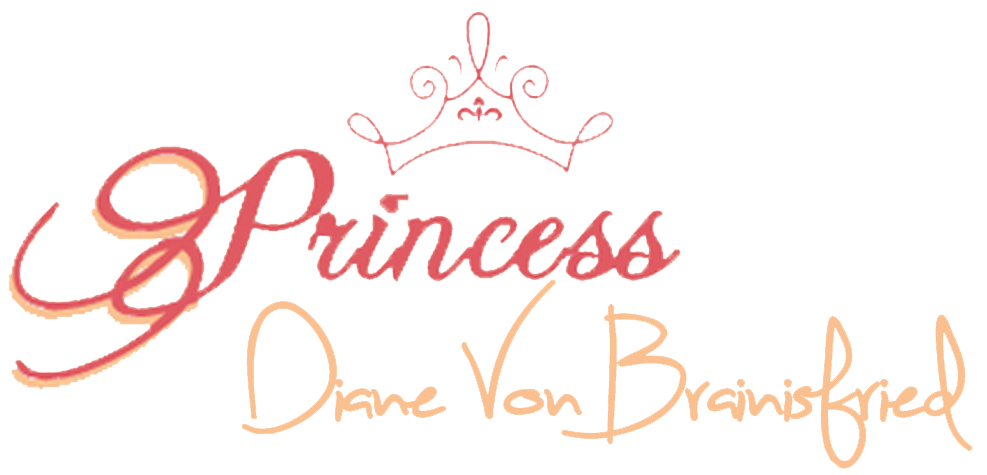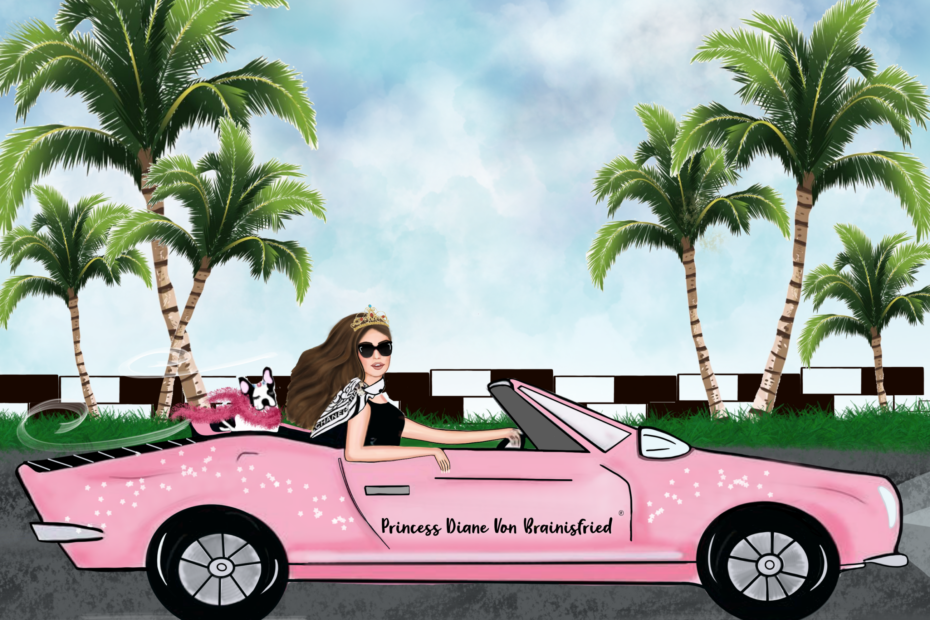Bonjour Royal friends!
Welcome to my blog, a ‘tongue-in-chic’ happiness lifestyle guide from a funny princess point of view!
Today I write to you from my palace desk with some unbelievably good fortune! I have the thrill and honor of interviewing for my “Enchanting Discoveries Series~People Places Things” the internationally famous writer/naturalist/explorer Sy Montgomery!!! Hailed by The New York Times as “One of the finest chroniclers of the natural world,” Sy has been “chased by an angry silverback gorilla in Zaire and bitten by a vampire bat in Costa Rica…undressed by an orangutan in Borneo, hunted by a tiger in India…” and of course, apropos your princess…studied the elusive pink Amazon dolphins she first spied in the Ganges River in India! Can you imagine? No…. Until now!
Read on for this fascinating interview with the spectacularly interesting, uncommonly fearless, incredibly prolific, once-in-generations human being!!! And she’s a fabulous person too! Think Jane Goodall, Alice in Wonderland, Dora The Explorer, and Dr. Doolittle all in one!
Princess Positivity Tip: SUBSCRIBE to my blog so you don’t miss any adventurous, life-enhancing, happiness-boosting, positivity-provoking posts. Plus free gift!☀️💖👸🏻
ENCHANTING DISCOVERIES SERIES~PEOPLE PLACES THINGS: SY MONTGOMERY INTERVIEW
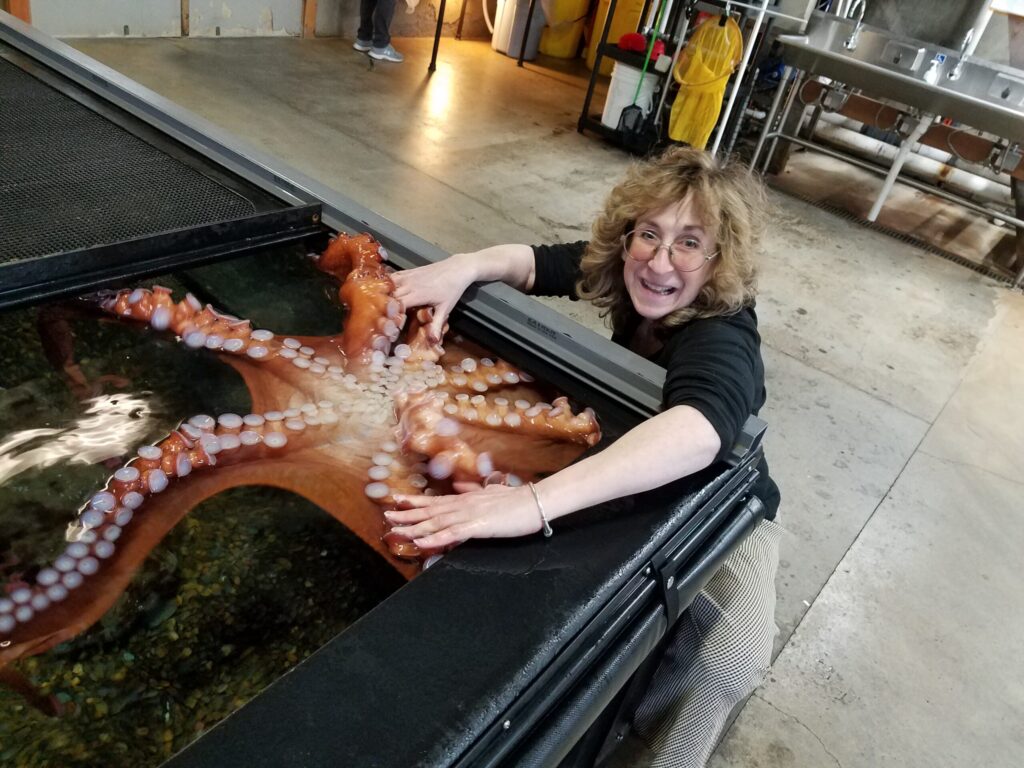
Sy and Cleo, A Giant Pacific Octopus at Oregon Coast Aquarium. Photo by Amy Kunze.
- PDvB: You’ve had a most extraordinary career traveling around the world to study all kinds of animals and sea creatures. We are so blessed that you’re also a writer, so that we can not only learn from your studies but also vicariously experience these adventures. Your escapades are often risky. You’ve said:
“In researching books, articles and documentaries, I sometimes get myself in a fix. I’ve been chased by an angry silverback gorilla in Africa and been bitten by bats in Costa Rica. I’ve had to pull leaches off my skin after slogging through swamps after orangutans in Borneo. I’ve been attacked by biting ants on three continents. In order to find and watch animals I write about I’ve skied over hills after bears and ridden elephants through jungles to find tigers. So maybe it shouldn’t have seemed strange to be hanging by a rope up a tree in the Amazon — except for one thing. I was trying to look for dolphins.”
Wow! I can’t even imagine! What is one of the most frightening pickles that you’ve ever gotten into and how did you extricate yourself?
SM: All the really scary stuff involved that most dangerous of species, the one called Homo sapiens. I’ve had a gun held to my head twice. The first time, in Rwanda, I was in the middle of nowhere with a “guide” to “protect me” as I climbed up the mountain to Dian Fossey’s then-empty cabin, where she had been murdered by the swipe of a machete. Her blood was still on the rug, her breath still in the festive holiday balloons hanging from the ceiling. The person with the gun wanted my money. I wasn’t about to hand it over. I did have a very old British 1-pound note that was out of circulation. I didn’t think he’d realize it was a useless bill. I told him that it was very valuable and that I would be delighted if he would take it as a token of my appreciation for his protecting me. The second time was in India and the guy was drunk. I didn’t think he would shoot me and just told him to put the gun down, which he did.
2. PDvB: When you were a child, you probably never thought you’d be bitten by bats, pulled off leaches, ridden elephants, and experienced all the other monumental adventures you’ve known. Reflecting upon your childhood self, do you recognize any qualities in you then, that you can now say…. aha! Now this all makes sense.
SM: Oh yes! Before I could speak and before I can even remember, my parents took me to the Frankfurt Zoo (I was born in Germany.) They lost track of me, as often happens with tots….and found me inside the hippo pen, with the hippos—all of us having a perfectly good time.
3. PDvB: It’s always interesting to know a little background about my Enchanting Discoveries! Can you riff a little about yourself, like where you grew up, where you went to school, what you originally planned to do as a career, and how you got on the writing/adventurer’s track you are on now.
SM: I pretty much always wanted to do exactly this. As a very small child, I reckoned I’d be a veterinarian. But as I began to read, I discovered that human behavior—not disease or injury–was what threatened my animal friends most, both as individuals and as species. That’s when I decided to become a writer. And to apprentice myself to my animal teachers, I needed to meet them where they lived—whether in the outback, or some jungle, or a rainforest, or in the sea.
In college (SU) I tripled majored (French, Psychology, Magazine Journalism) and, because they wouldn’t give me a 4th major, I took a lot of biology. Then I worked for a newspaper, initially covering nine rural towns but soon environment/medicine/science. After five years of reporting, my father gave me the great gift of a ticket to Australia—where I’d always wanted to go, because of the interesting animals there.
I decided to join an Earthwatch expedition and volunteer with a scientific project there. Dr. Pamela Parker of the Brookfield Zoo was investigating the hidden lives of Southern Hairy-Nosed Wombats in South Australia. We lived in tents and cooked over eucalyptus-scented campfires and spent our days among wombat warrens, with kangaroos bouncing across the landscape, parrots swooping overhead, and spiders the size of our hands visiting our tents. I was in heaven!
After two weeks it was time to go home, and Dr. Parker told me she wished I could come back, though she had no funds to hire me or even buy me a ticket to return. But, she said, if ever I wanted to do an independent study of an animal at her study site, she would feed me. So I quit my job at moved to a tent in the outback. I followed three emus around for six months, noting their every move—the first detailed, close-up behavior study of the species in the wild.
At the end of the Australian winter, I moved to NH where my husband, the writer Howard Mansfield, had already moved our stuff, and embarked with him on a life freelancing. Everyone thought we were crazy. Didn’t at least one of us have sense enough to move in with a doctor or banker—or at least somebody with an actual, paying job? But our marriage and our work has been wonderful beyond my wildest dreams.
4. PDvB: You write that your father was a big inspiration to you and had a great influence on your life. In WWII he withstood torture and captivity for years and he won the Purple Heart many times for bravery in saving others. You said he taught you that such courage “was possible only if you believe in something larger than, and more important than yourself.” You certainly have shown enormous courage during your career. I would have stopped at the leaches! What is that enigmatic something, that something larger than, more important than yourself that you believe in that is the driving force behind your work?
SM: Life with a capitol L. Not just my own life, precious as it is. But the larger Life, including all the sentient creatures, and the trees and mosses and grasses and rivers and seas, and all that dwell therein. Everything I write is a love story to Life—and within it, a plea that we humans respect, revere and restore the lives and the ecosystems we have trashed in our blindness and ignorance.
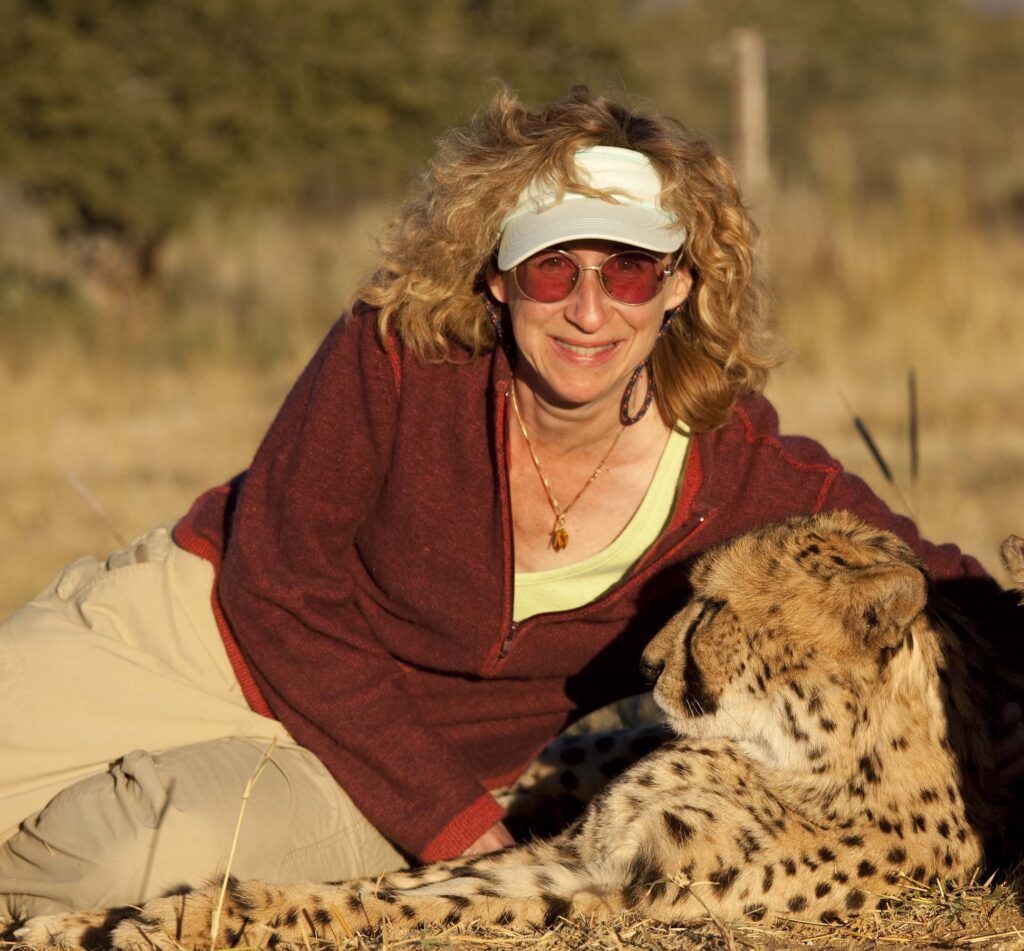
Sy with Cheetah. Photo Credit Nic Bishop
5. PDvB: You seem to be an adventurous person as well as an uncommonly courageous person. Did you need to cultivate either of these qualities, up your game so to speak, to match the measure needed for your expeditions? Can you give us some tips for cultivating bravery?
SM: You are generously giving me too much credit, dear Princess! I am not brave. You should see me cower at a cocktail party! I am so scared of going to the doctor that my blood pressure skies so high that he fears I am having a stroke! But when I am in the field, I am so single-mindedly focused on my work, and so in love with my subject, that my heart has no room for fear. My only fear associated with work is that I am unworthy to write the story.
6. PDvB: I’ve been so touched and moved by your books. Your writing is so powerful that the reader becomes attached to the animals and feels the emotions in the echo chambers of your heart. I cried with you over your sweet piggie Christopher Hogwood in The Good Good Pig and I cried with you over Octavia in the Soul of an Octopus. You brought these sentient beings to life so vividly, their personalities were so magnetic and real, and their longing to connect was so unmistakable. I was a vegetarian, but I had started carving out an exception for fish, including octopus. But after reading your book, I could no longer justify my fish exception. How could I eat these friends who recognized you and reached out of the water to hug you!
In your travels and conversations, have you learned that you inspired people to stop eating meat/chicken/fish? Was that one of the goals you had in writing your books?
SM: My goal has always been to show animals as thinking, feeling individuals who love their lives as we love ours. And to my delight, yes, I’ve had many readers give the great gift of sharing with me that they no longer eat the animal I was writing about. Personally, I gave up meat in my 20s, four decades ago. But I don’t judge meat-eaters. A lot of my friends, including a cheetah so calm he let me lie down beside him, are meat-eaters. (He was an orphan raised by Laurie Marker, of Cheetah Conservation Fund in Namibia, and now an ambassador animal living with her there.) There are some people who still eat meat but who in other ways—donations, political power, inspiring others—are major movers in the effort to protect our earth and its animals. Bravo to them! And my carnivorous friends are always welcome at our table to enjoy a delicious, healthy, meatless meal–without a lecture.
7. PDvB: You have such amazing relationships with the animals and fish you study and it’s fascinating to read about how you communicate with them. I’d love to hear your understanding of what intelligence is. Not so much in the quantitative sense of “IQ” (although some of those octopuses could probably beat me at chess) but in some qualitative sense. How do you recognize levels of intelligence in other life forms when you study them, as opposed to instincts? What do you think are the implications to us humans, our duty toward them, once we recognize intelligence in animals?
SM: There are multiple forms of intelligence. We’ve heard of linguistic intelligence and mathematical intelligence, for instance, but now we recognize emotional intelligence. Kinesthetic intelligence. Spatial intelligence. It goes on and on. I think instinct is a form of intelligence. We humans obey instincts all the time, but we don’t necessarily recognize it. Instinct is wisdom handed down from our ancestors—not orally, or in writing, but in our genes.
But of course, we can’t restrict our compassion only to those whose intelligence most closely resembles our own. No mathematician would ever want to be friends with me! We maximize joy by delighting not just in our sameness, but our differences, too.
8. PDvB: All your adventures seem quite epic to me in that what you learn goes far beyond facts about animals, but also lessons about the world and yourself. One escapade of yours reminded me of a line in Shakespeare’s play Richard III, “A horse, a horse, my kingdom for a horse!” In your case it was your kingdom for a tooth! You were finally on your way to find the pink dolphins and on the plane ride over, a filling fell out leaving you in great pain. Things tumbled downhill from there, and yet in the end, you found that the “disasters” turned out to be a blessing in disguise.
As a positive psychology life coach, motivational speaker, and breast cancer survivor, I often write about finding a positive perspective in challenges we face. So, it strongly resonated with me when you framed the seeming misfortune as a blessing in disguise. Is it your general experience that things that seem like failures are not failures and can you give us an example?
SM: You are so great at finding the silver lining, dear Princess! And sometimes the lining is the best part. In the example with which you began this chat, I was working on a book on pink Amazon river dolphins and having a miserable time seeing them. They don’t leap to the surface like marine dolphins. Instead, they inhabit often-dark waters of the flooded forest, swimming with great grace and flexibility among the drowned branches of trees.
From the boat, I had trouble spotting them for more than just a second or two. So I climbed up a machimango tree to try to get a better look from a different angle. It was quite the journey. I was pulling myself up with this harnass-type gear, and I had never done such a thing before.
Below me, people were fishing for piranhas. But the higher I climbed, the more cool stuff I saw: below me, I could see parrots flying. On a high branch of the tree, I could look inside the natural bowl formed by of the petals of a bromeliad flower, which grows only on tall trees. There, the water caught in the petals formed an entire, miniature lake, full of tiny creatures who live there and only there. When I looked down, I couldn’t see the dolphins any better than before. But I had discovered an entire world in the tree canopy I never would have otherwise seen.
9. PDvB: So much of your work takes you to worlds alien to most of us. You always seem to find ways to communicate with all the wonderful creatures you study. If you met a real alien, what have you learned from your studies of animals and fish that would help you discover more about the alien and find common ground?
SM: I would simply watch and listen, quietly, and act non-threatening. I would let the creature make the first move. This is how Jane Goodall worked with her chimps. She didn’t try to hide from them. But she went to a place she called The Peak, where they could see her from a safe distance, and discover she meant them no harm. This was an utterly new approach—and a revelatory one. For eventually, the chimps came to accept her presence among them, and let her see behaviors never before recorded.
10. PDvB: You’ve written that many of your teachers were animals. What are some of the most profound lessons from animals that you’ve learned?
SM: I write about this in my memoir, How to Be A Good Creature. They have taught me nearly everything! When my own family disowned me (for marrying Howard), our pig, Christopher, taught me that a family is built out of love, not blood. Molly and the emus taught me how to find my path in life. An ermine taught me how to forgive; our current border collie, Thurber taught me how to trust in the future.
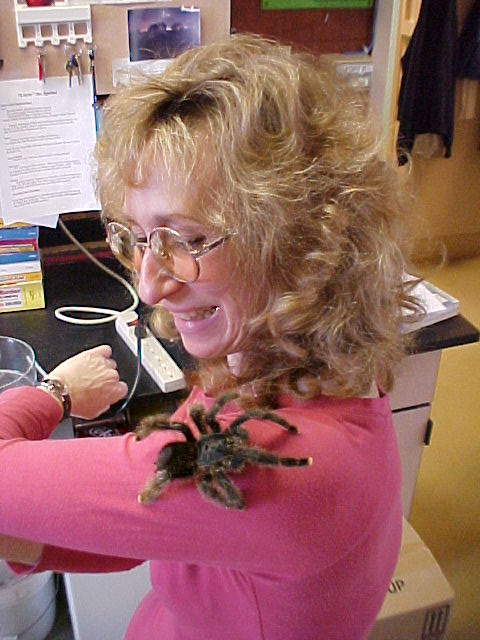
Sy with tarantula. Photo credit Sam Marshal
11. PDvB: As a writer, when you get ideas to write about various animals and, as you say, one thing leads to another, do you get a kind of magic moment, a lightning bolt, when you get an inner message saying, “Yes, this is the one calling me to explore!” Or do the ideas bubble up more softly.
SM: Sometimes one book leads to another. For instance, in India I saw Gangetic river dolphins—which led to my book on pink Amazon river dolphins. I was giving a talk on my pink dolphin book when I met Dr. Lisa Dabek, who studies tree kangaroos—and that lead to an expedition with her to Papua New Guinea and a book on her work. In the Amazon I met Dr. Gary Galbreath, and that lead to a later book with him on Asiatic moon bears. But for other books, including Soul of an Octopus and Of Time and Turtles, I have wanted to write on certain topics, like the mysteries of consciousness and time, for many years, and just felt the time was right to explore them.
12. PDvB: What do you think is a key attribute for success as a writer and what’s the most difficult part of the writing process for you? Is there anything that is like Kryptonite to your writing process? How do you overcome it?
SM: The hardest part for me is generally getting the first sentence. Much easier, generally, from there. Sometimes writing feels easy and natural; other times it’s like tearing my lungs out.
But failure has never been an option for us. Both Howard and I have made our lives writing and working for ourselves. If you don’t sell your book, you have to eat rocks from the driveway. To do this requires not just talent and luck but crazy, passionate laser-focused love—love strong enough that you are happy to live off the scent of an oily rag if you need to.
13. PDvB: If you hadn’t chosen a career as a writer, what might you have wanted to be or do?
SM: I would have needed to work helping animals in some other way. Wildlife rehab, anti-poaching, field research.
14. PDvB: You said one of your best friends and teachers as a child was a Scottish terrier named Molly and “From her, more than anyone else, I learned to imagine what the world might be like to be a non-human creature.” The animals also helped you “broaden the focus of my interests beyond my own species, to take in a bigger world.” If you could ask your pig Christopher Hogwood, or Octavia the octopus, the man-eating tigers, the Golden Moon Bear, the magical pink dolphins, and the apes, how you might have broadened their world, what do you think they would tell you? And if these animals could whisper in your ear so you could tell us what they would like us to know, what do you think that would be?
SM: I definitely broadened Christopher Hogwood’s world—and his waistline! But seriously, I think for the individual animals I have known and loved, I think I gave them what we all want from those close to us: play and meals together, company, gentle touch. I can’t tell to what extent these individuals were aware of the human world; but surely they would want us to understand that their lives matter.
15. PDvB: Your adventurous, well-lived life is so romantic to me! You’ve had incredible escapades to exotic places. You’ve frolicked and made friends with strange and wonderful animals. You’ve penned stories that stoke and stretch the imagination that might be fiction, expect they are true! And, finally, you write from home in a 150-year-old New Hampshire farmhouse which you share with your husband Howard and your third border collie, Thurber. This is all the stuff of dreams come true. What do you dream of now for your future?
SM: This year, I am already working on three books that I’m excited about: a picture book on caterpillars illustrated by the superb wildlife artist Matt Patterson; a book about my August/September scuba expedition with giant oceanic manta ray researcher Michel Guerrero; and some essays to accompany an anniversary edition of Joel Sartore’s book of astonishing portraits of endangered animals, The Photo Ark. In September, Matt and I are looking forward to publication of our picture book The True and Lucky Life of a Turtle, about our snapping turtle friend, Fire Chief. But this year I am making a conscious effort to slow down a bit, to make emotional space and time for something wonderful to happen. I wonder what it will be?
16. PDvB: In The Good Good Pig, you wrote:
“Ever since we left that garden, we have been longing for Eden. It is a testament to human blindness that so few of us find it. “Heaven,” wrote Thoreau, “is under our feet.” Heaven, Eden, paradise, the Encante—call it what you will. It is as close as a backyard or a barnyard, and as extensive as the Amazon. Granted, in the Amazon, one might need a dolphin as a guide. But in Hancock, all you needed to point you to Eden was a good pig.” (p. 145)
When you ponder all your daring journeys around the world to research animals strange and beautiful, dangerous and delightful, I think I observe a connecting theme in the form of a quest to live life with Heaven under your feet. Do you have any advice to help point us in the direction of Eden, especially for those of us who do not know furry or fishy friends or a good good pig like your dear friend Christopher Hogwood?
SM: What a wise question. The good news is our Earth already IS heaven. It’s here, before us, beneath us, around us. But so many of us have forgotten this, or turned away—and that is how we wake up one day to find out the world is on fire, and our oceans are filled with more plastic than fish. It is easy to connect with our Earth again, even in a city.
My friend Dr. Lisa Dabek, who today studies tree kangaroos in Papua, New Guinea, grew up in New York City, loving animals. She was allergic to cats and dogs—so as a child she studied the ants crawling on the asphalt roof of her home. Pigeons offer us an extraordinary close-up and intimate view of birds—they will court their mates, build their nests, and raise their young right under our noses, even in a city.
If you have a tree in your yard—any tree at all—it’s full of dozens if not hundreds of amazing creatures. And we can help them all, every day, with so many of the choices we make, from what we buy, what we eat, what we drive, how we vote.
For more information about Sy’s cool life, adventures, and her fabulous books, go tohttps://symontgomery.com
Royally yours with love, ✨👑💖
Princess Diane Von Brainisfried
Self-love action of the day: SUBSCRIBE to my blog so you don’t miss any adventurous, life-enhancing, happiness-boosting, positivity-provoking posts. Plus Free gift! ☀️💖👸🏻
x♥x♥x♥,
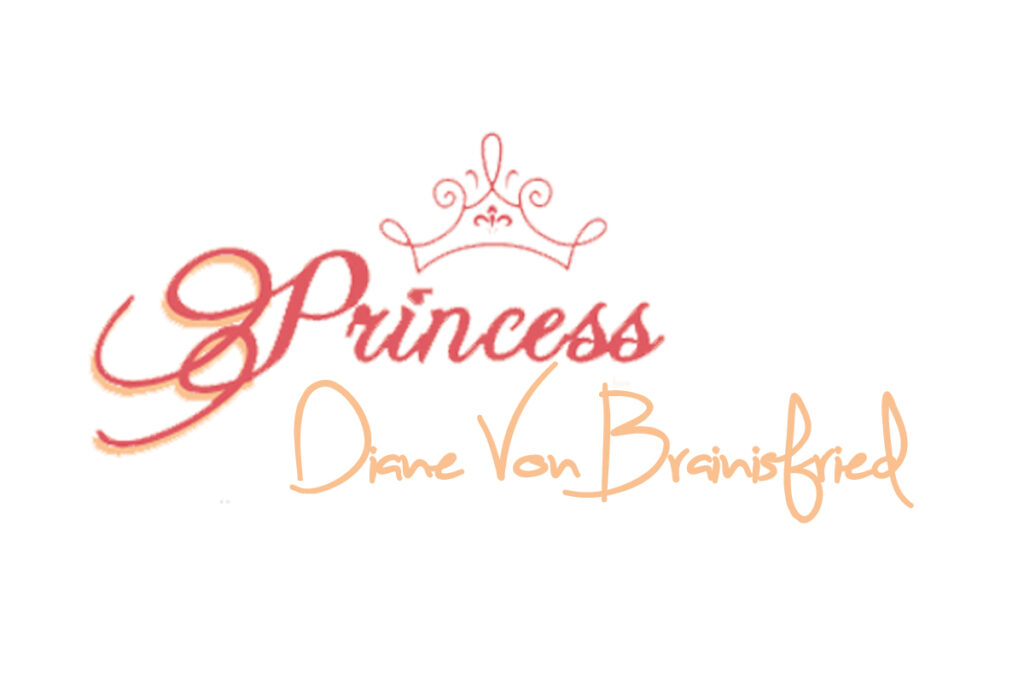
GET DAILY INSPIRATION! Download my FREE pdf printable poster, “24 Powerful Motivational Quotes to Pump Up Positivity!” with a FREE subscription to my periodic happiness lifestyle posts!
Dame Diane Uniman, Aka Princess Diane von Brainisfried, is an attorney turned motivational speaker, certified positive psychology life coach and award-winning writer. She wrote Bonjour, Breast Cancer-I’m Still Smiling…Wit, Wisdom, and Optimism for Beating the Breast Cancer Blues.
